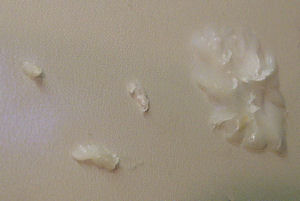(continued from previous page)
On the previous pages, we’ve seen how ShapeLock plastic can be melted and the kinds of shapes that can be created. It is possible to lock the plastic on an object if the shape can be wrapped around or otherwise provide a mechanical grip. I wanted to see what types of materials the plastic would chemically bond with, and not bond with, to determine the types of usages where no mechanical connection is necessary and the types of usages where the plastic is removable.

ShapeLock melted and bonded to a plastic binder cover.
An accidental bonding occurred when my son attempted to use his binder as a flat surface for rolling the molten plastic. The ShapeLock plastic immediately and permanently stuck to the clear binder window (likely made from vinyl).

Testing bonding of ShapeLock on various materials.
I cleaned a collection of scraps from my basement machine shop with plain water. (It would have been a better to have cleaned them with soap and water, to remove surface oils.) The ShapeLock plastic was heated to 190° Fahrenheit in the oven, applied by hand to the scraps, and then both the scraps and ShapeLock were heated together in the oven for about five minutes. They were then allowed to cool gradually at room temperature.

ShapeLock doesn’t bond to brass, aluminum, or Teflon.
It was obvious that ShapeLock plastic does not chemically bond to certain materials in my tests, as ShapeLock simply popped off or slid off. The metals include: aluminum, anodized aluminum, brass, copper, silver/tin (lead-free) solder, stainless steel, and zinc-plated steel. The plastics/rubber include: Delrin (acetal), FR-4 glass epoxy (PCB), nylon, polypropylene, silicone, and Teflon (PTFE).
Teflon is interesting, in that the ShapeLock did not bond with it, as expected. This means that the Wilton “non-stick” cookie tray that absolutely bonded with ShapeLock is not coated with Teflon.
You can machine or assemble a mold from these materials to cast much nicer shapes than those I created by hand. Theoretically, the ShapeLock material should release from such a mold with ease. Furthermore, if the mold is made from metal, you can cool the mold in ice-water for faster production of parts.
There is a possibility that surface oils or the large size of some of the test materials prevented bonding, whereas thin clean samples would have bonded. Some web postings suggest that cooling the surface of the ShapeLock plastic before pressing it against another material will reduce bonding.

ShapeLock plastic shears rather than pop off polycarbonate and acrylic.
On the other end of the spectrum, ShapeLock appears to bond with a number of common plastics. ShapeLock wouldn’t come off of these materials by hand, nor when I put them in a vise and tried to pop off the ShapeLock with a hammer. The ShapeLock material eventually distorted, but wouldn’t dislodge. The plastics that it appears to bind with include: ABS (Lego bricks), acrylic, polycarbonate, polyester (likely), PVC (polyvinyl chloride), and vinyl (likely).
There were two materials that received mixed results: wood and expanded PVC. The ShapeLock came off with tiny bits of the sample material embedded in it. I couldn’t tell if the sample material was weak (meaning the ShapeLock bonded but the material ripped away) or dirty (meaning the ShapeLock locked onto the fibers mechanically, not chemically).

Testing screw alloys and a circuit board with ShapeLock plastic.
Finally, I applied ShapeLock to a circuit board with four different alloys of machine screws installed. After the plastic cooled, I turned on the circuit and saw that it functioned well and was undamaged. The plastic’s resistance measured infinite on my multimeter, which confirms the published data that polyester substances are good electrical insulators.
With a little bit of effort, the ShapeLock plastic was pried from the circuit board to reveal the matching pattern of the circuit board. Some of the grime and no-clean rosin residue embedded in the plastic, contaminating any non-toxic reuse.
The fasteners can unscrew from the ShapeLock plastic, resulting in a threaded part. This could be a quick way of creating prototypes with ready-made threads. However, the threading is much tighter than threads made by a proper tap. This makes it more difficult to screw and unscrew, as well as reduces the likelihood that the threads are going to survive many cycles of use. On the upside, the screws are highly unlikely to come loose due to vibrations, so it is like building in a nylon-nut or other anti-vibration technology.
I’ve seen some people make battery holders and motor mounts with the ShapeLock plastic. Also, I’d like to try making some spacers (similar to commercial nylon spacers) and some colored parts. I made a nut for an unusual thread-size bolt.
As of the time of writing this, I haven’t tried machining (drill, lathe, mill, table saw, or sand paper). I would expect to use slow speeds and high feeds. That is, you need to avoid having the material melt when cutting it. So, you take large cuts into the relatively soft material rather than generating heat through friction by rapidly rubbing against small areas. That suggests that a Dremel rotary tool would be a bad choice.
As soon as I perfect my usage of it, I believe the ShapeLock plastic will become irreplaceable in certain robotic applications. Like any material, the trick is knowing when to choose it.